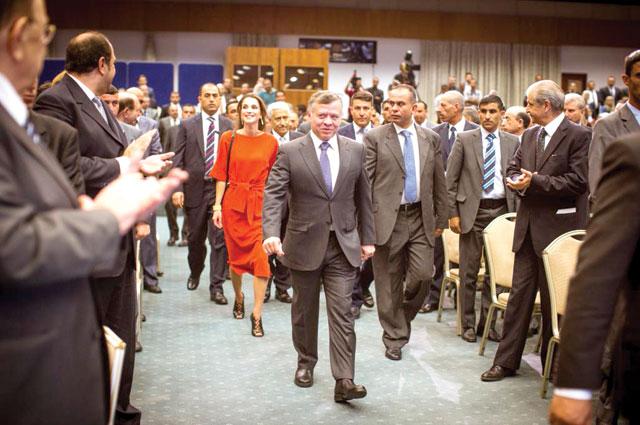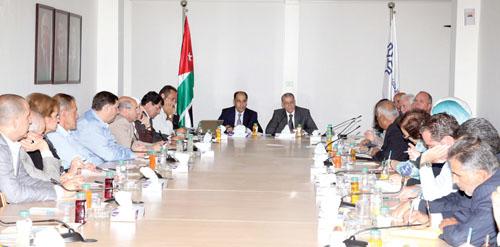You are here
Gov’t launches ‘Jordan 2025’ development blueprint
By Omar Obeidat - May 11,2015 - Last updated at May 11,2015

AMMAN – His Majesty King Abdullah on Monday attended the launch of "Jordan 2025", the 10-year blueprint for economic and social development.
The plan, also dubbed “2025 vision”, is based on two scenarios, a conservative one that assumes that the economy would grow by 4.8 per cent in 10 years, and an ambitious scenario that suggests the economy would expand by 7.5 per cent in 2025, Prime Minister Abdullah Ensour said in his remarks at the ceremony.
The premier said the ambitious scenario is still realistic.
The launch of the document was also attended by Her Majesty Queen Rania, senior officials, lawmakers, and private sector and media representatives.
The prime minister said the document features a long-term vision for Jordan's economy that includes over 400 policies and measures to be implemented by the government, private sector and civil society to support economic development in the coming decade.
He added that these policies and procedures seek to boost the rule of law and equal opportunity, and achieve financial sustainability and self-sufficiency.
Ensour described drawing up a realistic vision for Middle East countries as a gamble due to wars and unexpected turns of events in the region.
Taking into account unforeseen and accelerating regional uncertainties, he said the vision is flexible as it could be reviewed and adjusted periodically to respond to regional and local developments.
Minister of Planning and International Cooperation Imad Fakhoury said the main objectives of the blueprint are to address the challenges of rising living costs, poverty and unemployment and to lead the community to a more prosperous level in the coming 10 years.
Fakhoury said the vision is based on 20 developmental priorities derived from four pillars representing the key players in the plan: citizens who are highly motivated to participate in the development process, a secure and stable society, a dynamic private sector that is able to compete internationally, and a competent and effective government sector.
On how to improve the economic situation, the blueprint envisions Jordan as a regional economic gateway to regional markets that is also taking advantage of free trade agreements the Kingdom has signed with several countries in order to achieve an export-oriented economy, the minister said.
The formula used in the blueprint, Fakhoury explained, is based on the concept of economic clusters based on the cooperative advantages of the Kingdom, adding that the vision aims at achieving relatively high economic growth rates and a tangible drop in unemployment and public debt, which planners expect to decline to 47 per cent of the gross domestic product (GDP) in 2025.
Currently, the debt ratio to the GDP is nearly 81 per cent.
On the implementation of the scheme, the minister said it would be carried out through three executive programmes, adding the government has recently started preparations for the 2016-18 executive development programme, which is the first phase of the vision’s implementation.
Ensour said that a special unit was established at the Prime Ministry to follow up on progress made in implementing the executive programmes and to report progress to the public.
In March this year, the King sent a letter to Ensour directing the government to prepare a plan that would result in a stronger economy, in both macroeconomic and monetary aspects, and ensure consistency, increased competitiveness, productivity and self-reliance.
The ultimate goal, His Majesty said, is to achieve comprehensive development and ensure Jordanians are secured a “decent living and hope for a better future”.
This economic blueprint should have a comprehensive framework that seeks to realise the following: enhancing financial and monetary policies and assuring their consistency; improving economic competitiveness; and enhancing values of high productivity and self-reliance to realise sustainable and comprehensive development, the Monarch said in the letter.
Key targets included in the Jordan 2025 vision
The Jordan 2025 economic vision seeks to increase GDP growth rate from 3.1 per cent to7.5 per cent in 2025.
The vision also seeks to reduce poverty rate from a current 14 per cent to 8 per cent and decrease unemployment rate from 12.2 per cent to 8-9.2 per cent.
In addition, the vision aims to raise women’s participation in the labour market from 15 per cent to 24 per cent.
|
Sector |
2014 |
2017 |
2021 |
2025 |
|
GDP growth rate |
3.1% |
4.9% |
6.9% |
7.5% |
|
Percentage of local revenues coverage of current spending |
86.4% |
100.1% |
114% |
130% |
|
Budget deficit ratio to GDP including grants |
3.5 % |
1.2% |
0.8% |
0% |
|
Budget deficit ratio to GDP excluding grants |
8.1% |
4% |
1% |
0% |
|
Public Debt ratio to GDP |
82.3% |
76% |
57% |
47.4% |
|
Government efficiency |
49.8% |
55% |
60% |
65% |
|
Government ranking in Global Competitiveness Index (GCI) |
24 |
18 |
16 |
12 |
|
Agriculture sector contribution to GDP |
2.9% |
3% |
3.2% |
3.4% |
|
Domestic share in energy mix |
2% |
6% |
22% |
39% |
|
Renewable energy share in energy mix |
1.5% |
4% |
7% |
11% |
|
Nuclear energy share in energy mix |
- |
- |
- |
15% |
|
Construction sector contribution to GDP |
unavailable |
4.5% |
5% |
6% |
|
Industrial sector contribution to GDP |
22% |
23% |
25% |
27% |
|
Services sector contribution to GDP |
68% |
66% |
63% |
61% |
|
Investment volume and growth rate |
JD2.2 billion |
7.8% |
8.3% |
8.8% |
|
Business Environment- Ranking in GCI |
64 |
60 |
55 |
50 |
|
Judicial independence ranking |
48 |
42 |
40 |
38 |
|
Extreme poverty rate |
14% |
13% |
10% |
8% |
|
Unemployment rate |
12.2% |
11.5% |
10.8% |
8%-9.2% |
|
Percentage of employees in public sector |
38% |
34% |
32% |
30% |
|
Women participation in labour market |
15% |
18% |
22% |
24% |
Related Articles
The government is finalising its 10-year blueprint for the Kingdom's economic and social policies, dubbed "Jordan 2025", which will be ready before the end of this year, Planning Minister Ibrahim Saif said Sunday.
Planning Minister Ibrahim Saif on Monday briefed members of the Economic and Social Council (ESC) on the framework of the economic and social policies of the Kingdom’s “2025 vision”.
Prime Minister Abdullah Ensour on Thursday said that Jordan's “2025 Vision” for the economy currently being prepared will be assessed every three years to take into account the region's unpredictability and global uncertainties.
















